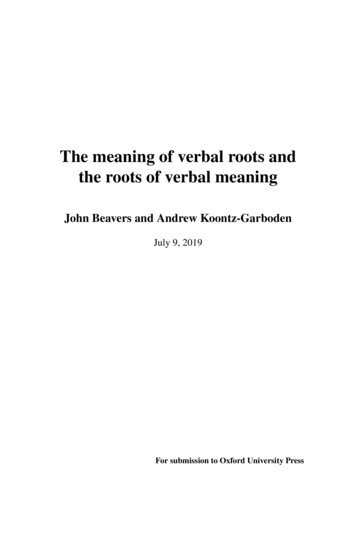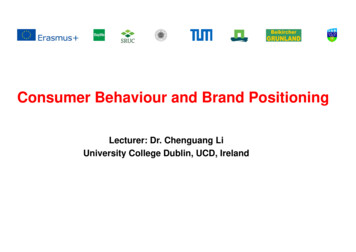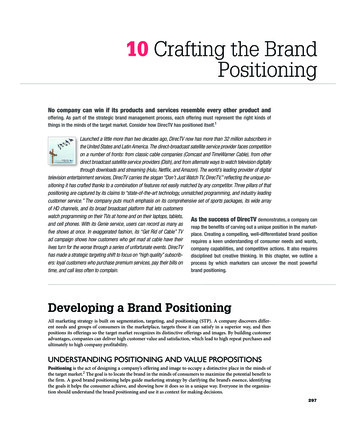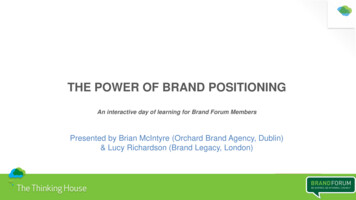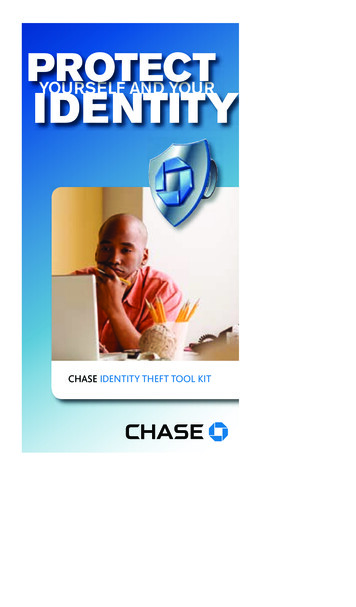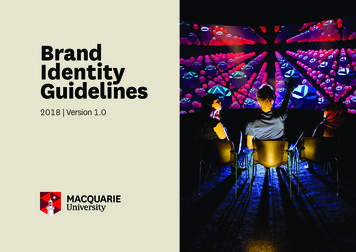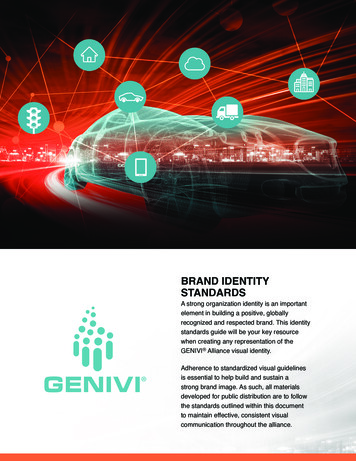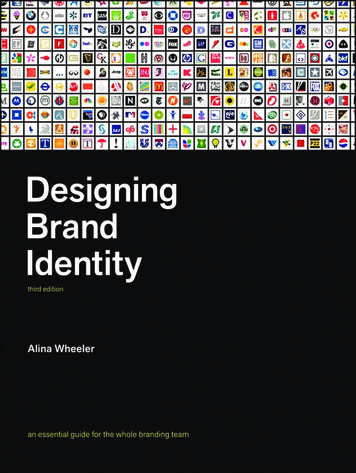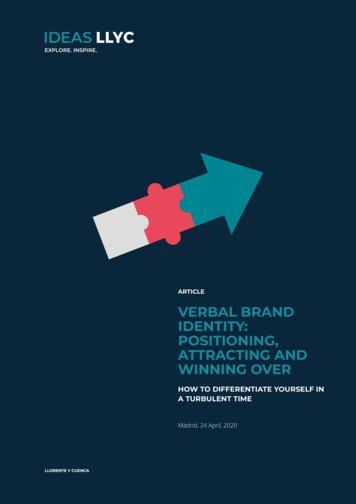
Transcription
Verbal brand identity: positioning, attracting and winning over1ARTICLEVERBAL BRANDIDENTITY:POSITIONING,ATTRACTING ANDWINNING OVERHOW TO DIFFERENTIATE YOURSELF INA TURBULENT TIMEMadrid, 24 April, 2020ideas.llorenteycuenca.com
Verbal brand identity: positioning, attracting and winning overVERBAL IDENTITY: THE BRIDGEBETWEEN STRATEGY ANDCOMMUNICATIONWith the arrival of COVID-19 and while peoplelock themselves away in their homes out offear for their own personal health and theirloved ones, brands are regaining our attention.We are seeing similar initiatives and contentemerge and overlap in attempts to tackle a majorcommunication challenge. Never before has itbeen so easy to speak, and never before couldthe results have been so costly.Answer these questions whileconsidering the four maincomponents:1. VOICE TONE2. BRAND MANIFESTO3. MESSAGING MATRIX4. NAMING SYSTEMSWhat can your brand do to build a solidcommercial and reputational recovery?In times such as these, we need to rememberthat our brand is much more than just a logo orsimple advertising announcement: it is one ofthe company’s most important strategic assets,responsible for building emotional relationshipswith people. Especially now, we yearn for a way toexpress authenticity and differentiate the brandso the organization’s DNA can be conveyed,and connections built with stakeholders: verbalidentity. A tool that employs linguistic andnarrative techniques, empowering brands to telltheir story and be perceived in a tangible andcoherent manner.Still the least well-known aspect of branding,verbal identity is the key to humanizing thebrand and connecting it to its audiences. It isnot “only” about doing and saying, but ratherabout knowing HOW to do it and say it. Becausehaving a communication strategy is as vitallyimportant for dealing with any crisis, as isimplementing that strategy while protecting,conveying and strengthening your brandidentity.2“Still the leastwell-known aspectof branding,verbal identityis the key tohumanizingthe brand andconnecting it to itsaudiences”Has your brand built a verbal identity? If so, hasit helped you more effectively respond to thechallenges of COVID-19?ideas.llorenteycuenca.com
Verbal brand identity: positioning, attracting and winning overCan you imagine if Ikea used “Sir” and “Madam” toaddress you or if the Cirque du Soleil had no musicduring its performances? Can you imagine if Nikeencouraged you to binge watch TV series during thisconfinement?A fine example can be found in,avirtual mobile operator of Vodafone in Spain,which has such a strong and recognizable verbalidentity that its teams and agencies consider itto be the guiding principle when building brandcommunications. Lowi’s tone of voice is basedon cool, empathy, informal speech and fun, allcross-cutting concepts that are reflected in all itscontent and that highlight the “customer-centric”strategy implemented by the company. The mostinteresting thing is that, despite being a virtualbrand, it does not only apply its tone of voiceto advertising campaigns and its social mediabut also to all the brand’s points of contact - thewelcome letter sent to customers, router, callcenter guidelines, etc. - to create a coherent andmemorable brand experience.That consistency in the use of its own language isprecisely what has enabled it to stand out fromother competitors in a market saturated withsimilar products, where brands become the maindistinguishing feature for companies.1. VOICE TONEThis is the way in which we express what we wantto communicate. It encompasses the verbal,visual and attitudinal aspects of the brand thatexpress what the company is like. It manifeststhrough WHAT IS SAID by the brand (values andpersonality traits) and through HOW IT IS SAID(words, structures, expressions, idiosyncrasies).A tone of voice guide contains all the linguisticresources needed to express the company’sattitude in any message, in any of the brand’scommunication channels and consistently overtime.The tone of voice of the brand has enabledLowi to launch campaigns such as this latestone during the COVID-19 situation focused onsocial media: “If you stay at home, we’ll stay withyou”. Why? Because the brand has already builta personality that is perceived by its customersand that enables it to launch initiatives aimedat achieving engagement and strengthening itsposition without jeopardizing its legitimacy. Inthe campaign, Lowi identifies the social insightsemerging from the crisis, such as sharing,balconies and messages of encouragement, andadapts its tone of voice to each social media.ideas.llorenteycuenca.com3
Verbal brand identity: positioning, attracting and winning over2. BRAND MANIFESTOthis is a key component because it consists ofa public declaration of a company’s intentionsand the strategic pillars on which it is based. Itis an inspiring, emotional and courageous pieceof communication material because it revealsthe commitment made to others by the brand(to society and/or its customers). It is a “war cry”through which the brand conveys its vision andseeks to mobilize internal and external audiencesto join forces. To develop a brand manifesto,you need to consider the values, personality andattitude of your company and respond to the roleit plays in society.However, a brand manifesto is not enoughon its own because it is merely one piece of alarger jigsaw for which it must be a perfect fit.Those brands that have a powerful manifestoare those that have successfully madethemselves stand out from their competitorsand unequivocally transmit a unique personalitywith which consumers identify. This is the caseof, a Spanish brand ofbeers that seeks to be a “Love Brand”: the mostloved brand.Estrella Galicia has a well-built identity and hassuccessfully identified and consistently held onto its distinguishing characteristics: authenticity,traditionality and Galician quality. A part of itssuccess lies in its ability to distance itself fromthe inherent standardization in the market anddifferentiate itself from other strong beer brands.How? By looking after its product and by itsvindicating and rowdy attitude. Estrella Galiciahas perfectly enshrined this attitude and purposein its brand manifesto.Fragment from the Estrella Galicia ManifestoThrough its manifesto, the brand addresses thoseconsumers who share its lifestyle philosophy.Unlike other companies that speak to everyonewhile running the risk of not mattering to anyone,Estrella Galicia takes courageous decisions. Asthe saying goes, “strategy is the art of sacrifice”and sacrifice is essential in a brand manifesto inorder to make safe bets.“Those brands thathave a powerfulmanifesto arethose that havesuccessfully madethemselves standout from theircompetitors andtransmit a uniquepersonality withwhich consumersidentify”ideas.llorenteycuenca.com4
Verbal brand identity: positioning, attracting and winning over3. MESSAGING MATRIXIt will be key to illustrate the messages thatthe company should send with examples,guaranteeing communication that is in line withthe brand identity and that generates recognitionin the market. This matrix consists of standardmessages aimed at training other people atthe company and agencies to generate contentwhile guaranteeing consistent communication.The success of any messaging matrix lies inknowing how to adapt tone of voice concepts toeach communication channel and stakeholdergroup, because your brand should be flexible andcapable of adapting itself to different audienceswithout losing its essence.Amid this Coronavirus crisis, Dove has launchedits “Courage is beautiful” campaign to pay tributeto healthcare workers. This campaign seeks tostress that courage is beautiful and to continuechallenging the aesthetic standards created bythe media. Only a brand like Dove, which hasbuilt credibility and a unique space through itsverbal identity, can launch such a campaignwithout seeming to be opportunistic.5As an example of a brand whose globalrecognition can be largely attributed to its strongverbal identity, we have chosen Dove. In everycountry where it operates, this brand launchesconsistent messages centered around its conceptof beauty: real beauty.Dove’s voice is one of a brand that encourageswomen to create a world in which beauty is asymbol of confidence, not frustration or concern.One of the keys to its success is based on theability to consistently apply its unique andrecognizable tone of voice regardless of thespecific circumstances in question. The contentand form of the messages used by the brandare undoubtedly the brand’s insignia: uniform,positive, encouraging and focused on real beauty.The fact that Dove not only has a well-builtidentity but also actively operates its brand inline with that identity has enabled it to achievean indisputable market position. The brand hastaken decisions, such as to stop using models inits campaigns and commit to training in order toimprove the self-esteem of women and girls, thatonly further bolster its image.https://www.youtube.com/watch?v csIerE0578w&feature emb titleideas.llorenteycuenca.com
4. NAMING SYSTEMSThe set of names used for your brands, products,services, campaigns, hashtags, etc. says a lotabout you to internal and external audiences.Have you ever thought about the ecosystem ofyour brand’s naming system? Does it enhanceyour value promise? Is it coherent across theboard? You will most likely find naming systems indifferent languages, classifications and appealingto different semantic territories. This merelydistorts your brand image. Creating any namingsystem involves a strategic-creative exercise thatconsiders multiple aspects and is so profoundlyimportant that we will dedicate an entire paper tocorrectly cover this topic and explain the benefitsof having guidelines on the creation of names.6What good is building a verbal identity?The same examples we used before help usunderstand that only those brands that havebuilt up a verbal identity over time can emergestronger from moments of crisis.A verbal identity will help us:1. Position the company in the market throughconsistent stories that unequivocally give life tothe brand promise.2. Attract, impact, convince and sell. The wayand manner in which the company addressesothers is fundamental to creating an impact,being believable and connecting with others.3. Create rules and guidelines to enable andhelp teams generate content while guaranteeingbrand coherence.ideas.llorenteycuenca.com
Verbal brand identity: positioning, attracting and winning overEverything described above are stimuli that willimpact externally and, as a whole, will eitherstrengthen the brand position or otherwisegenerate confusion and noise. Defining a verbalidentity guide will help you ensure your brandis perceived in the way you want, in line withits identity.Nonetheless, in spite of the good examples, weare seeing many brands during COVID-19 forgetabout their personality when venturing awayfrom their usual communication environments.Their opportunity lies in the opposite, inhighlighting the value of the brand. Because ageneric, incomplete or inconsistent brand identitymakes it very easy for consumers to miss themessage or confuse it with the messages fromother companies. As is the case with people, if wecease to convey what defines us as brands, wewill cease to have any impact on others.“If we cease toconvey whatdefines us asbrands, we willcease to have anyimpact on others”In conclusion, if, after what you have read here,you would like to know whether your verbalidentity is correctly defined, follow these threesteps:1. Conduct a review of recent actions andcampaigns. Can you identify your brand’spersonality in them?2. Look at the content of your online assets andreplace the brand’s visual components (logo, font,colors, etc.) with those of a competitor. Wouldanyone notice the difference between the twobrands?3. Conduct a small survey to reveal the healthof your tone of voice. Does the perceptionexpressed by the public about your brand matchits personality?If you have answered “NO” to any of thesequestions, you have a branding challenge aheadthat will become an opportunity to strengthenyour brand position once you have successfullydealt with it.ideas.llorenteycuenca.com7
Verbal brand identity: positioning, attracting and winning overAUTHORSAna Folgueira. Executive Manager of the CreativeStudio area. Ana Folgueira has a long-standing careerin the field of communication. She holds a degreein economics from UAM and a master’s degree increative writing from the Escuela de Letras. She taughtat university and worked for several years in venturecapital, supervising investments and monitoringstart-ups. She is the executive director of CreativeStudio, as well as founder of Dreamtellers Foundation(presently LLYC Foundation) and has taken part inover 50 audiovisual storytelling projects for differentorganizations and companies, including BBVA, EY,Siemens Gamesa, Schindler, Coca-Cola and Campofrío.afolgueira@llorenteycuenca.comBarbara Ruiz. Manager of the Branding area at LLYC.Specialized in the field of branding. She previouslyworked in different areas of different companies(finance, marketing and foreign trade) which allowsher to adopt a holistic vision of brands understandingit as a promise of value that the whole company hasto make real through the brand experience. She hastaken part in strategic projects working in consultingfirms for brands such as CaixaBank, LaLiga, HitachiCooling & Heating, Orange, Riu Hotels &Resorts, Foster’s Hollywood, Licor 43, Pernod Ricard,Ron Barceló, among others. She has a Master’s degreein Brand Management from MSMK, has studied atrenowned universities such as Fordham University(New York, USA), Marquette University (Milwaukee),Johannes Kepler University (Linz, Austria) andBoston University (Boston, USA) as well as at ETEA(Córdoba, Spain) where she graduated in is art
verbal identity, we have chosen Dove. In every country where it operates, this brand launches consistent messages centered around its concept of beauty: real beauty.
